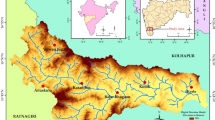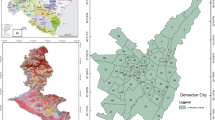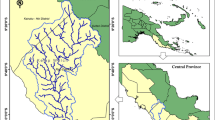Abstract
In view of an exponential increase in the negative impacts of flash-floods globally, the present work aims at the identification of flash-floods-prone river reaches in the Beas river basin, Himachal Pradesh, India using a multi-criteria indexing technique. The flood hazard index (FHI) was computed by implementing analytical hierarchy process (AHP) model on 6 hydrologic parameters influencing flood hazard, namely rainfall intensity, curve number (CN) grid, time of travel, slope, Manning's roughness coefficient and drainage density. The CN grid (empirical parameter to estimate direct surface runoff) was used as one of the parameters which depend upon the land use, hydrologic soil group and hydrologic conditions. It is imperative to mention that remote sensing and geographical information system (GIS) techniques played a crucial role in the preparation of these 6 parameter layers. The AHP model calculates the normalized weights for each parameter using pair-wise comparison matrices. The rainfall intensity and curve number were the factors having the highest normalized weight of 34.52 each. Subsequently, the estimated weights of the parameters and hazard level-wise rating scores were used in a GIS environment to generate FHI. The generated FHI raster was masked using floodplain layer within geomorphology map and river buffer to identify flash-floods-affected river reaches. The generated flash-floods map was validated by historical flash-floods ground points, field observations and remote sensing data. The results depicted that the river reaches in the north and east of the Beas basin are susceptible to flash-floods which are mainly governed by heavy rainfall intensity and high runoff characteristics. The river stretches namely Bahang–Manali (Beas), Kullu–Bhuntar (Beas) and Manikaran–Kheer-Ganga (Parvati) have been categorized into very high and high flash-floods zones. Decreasing trend of normalized differential vegetation index (NDVI) was observed for river reaches falling within the very high and high zones indicating the vegetation loss post successive flash-floods events. The river order 2 lies in the very high and high flash-floods zones, indicating the fact that the contribution of tributaries is significant to flood events. Flash-floods map will serve as catastrophic product, which will help policymakers to take suitable measures to reduce the risk of flash-floods.










Similar content being viewed by others
Explore related subjects
Discover the latest articles and news from researchers in related subjects, suggested using machine learning.References
Afshari S, Tavakoly AA, Rajib MA, Zheng X, Follum ML, Omranian E, Fekete BM (2018) Comparison of new generation low-complexity flood inundation mapping tools with a hydrodynamic model. J Hydrol 556:539–556. https://doi.org/10.1016/j.jhydrol.2017.11.036
Alonso JA, Lamata T (2006) Consistency in the analytic hierarchy process: a new approach. Int J Uncertain Fuzziness Knowl-Based Syst 14(4):445–459. https://doi.org/10.1142/S0218488506004114
Aneesh R, Deka PC (2015) Groundwater potential recharge zonation of Bengaluru urban district: a GIS based analytic hierarchy process (AHP) technique approach. Int Adv Res J Sci Eng Technol 2(6):129–136. https://doi.org/10.17148/IARJSET.2015.2628
Apaydin H, Erpul G (2006) Evaluation of indices for characterizing the distribution and concentration of precipitation: a case for the region of Southeastern Anatolia project Turkey. J Hydrol. https://doi.org/10.1016/j.jhydrol.2006.01.019
Arrowsmith C, Inbakaran R (2002) Estimating environmental resiliency for the Grampians national park, Victoria, Australia: a quantitative approach. Tour Manag 23(3):295–309. https://doi.org/10.1016/S0261-5177(01)00088-7
AzmeriIwan HK, Vadiya R (2016) Identification of flash flood hazard zones in mountainous small watershed of Aceh Besar Regency, Aceh Province, Indonesia. Egypt J Remote Sens and Space Sci 19(1):143–160. https://doi.org/10.1016/j.ejrs.2015.11.001
Bhatt CM, Srinivasa Rao G, Manjushree P, Bhanumurthy V (2010) Space based disaster management of 2008 Kosi floods, North Bihar, India. J Indian Soc Remote Sens 38(1):99–108. https://doi.org/10.1007/s12524-010-0015-9
Bisht S, Chaudhry S, Sharma S, Soni S (2018) Assessment of flash flood vulnerability zonation through Geospatial technique in high altitude Himalayan watershed, Himachal Pradesh India. Remote Sens Appl Soc Environment 12:35–47. https://doi.org/10.1016/j.rsase.2018.09.001
Buckley RV, Pickering CM, Warnken J (2000) Environmental management for alpine tourism and resorts in Australia. In: Price MF, Zimmermann FM, Godde PM (eds) Tourism and development in mountain regions. CABI Publishing, Wallingford
Chandel VBS, Kahlon S, Brar KK (2014) Flood disaster in mountain environment: a study of Himachal Pradesh, India. In: Thakur BR, Sharma DD, Sharma BL (eds) Managing our resources: perspectives and planning. Bharti Publications, New Delhi, India, pp 11–21
Dash P, Sar J (2020) Identification and validation of potential flood hazard area using GIS-based multi-criteria analysis and satellite data-derived water index. J Flood Risk Manag. https://doi.org/10.1111/jfr3.12620
Dhote PR, Aggarwal SP, Thakur PK, Garg V (2019) Flood inundation prediction for extreme flood events: a case study of Tirthan River North West Himalaya. Himal Geol 40(2):128–140
Dhote PR, Thakur PK, Aggarwal SP, Sharma VC, Garg V, Nikam BR, Chouksey A (2018) Experimental flood early warning system in parts of Beas Basin using integration of weather forecasting, hydrological and hydrodynamic models. Int Arch Photogramm Remote Sens Spat Inf Sci ISPRS Arch 42(5):221–225. https://doi.org/10.5194/isprs-archives-XLII-5-221-2018
Elkhrachy I (2015) Flash flood hazard mapping using satellite images and GIS tools: a case study of Najran City, Kingdom of Saudi Arabia (KSA). Egypt J Remote Sens Space Sci 18(2):261–278. https://doi.org/10.1016/j.ejrs.2015.06.007
El-Magd IA, Hermas E, Bastawesy ME (2010) GIS-modelling of the spatial variability of flash flood hazard in Abu Dabbab catchment, Red Sea Region, Egypt. Egypt J Remote Sens Space Sci 13(1):81–88. https://doi.org/10.1016/j.ejrs.2010.07.010
Federal Emergency Management Agency (2016) Flood insurance study. In J Edu 92(16). https://proxy.library.mcgill.ca/login?url=https://search.ebscohost.com/login.aspx?direct=true&db=sih&AN=21771910&site=ehost-live
Fekadu A (2018) Detecting flash flood hazard areas using geo-spatial–based analytic hierarchy process in Weidie Watershed South Western Ethiopia. J Remote Sens GIS 07(02):1–5. https://doi.org/10.4172/2469-4134.1000235
Fort M, Cossart E, Arnaud-Fassetta G (2010) Hillslope-channel coupling in the Nepal Himalayas and threat to man-made structures: the middle Kali Gandaki valley. Geomorphology 124(3–4):178–199. https://doi.org/10.1016/j.geomorph.2010.09.010
Gabr S, El Bastawesy M (2015) Estimating the flash flood quantitative parameters affecting the oil-fields infrastructures in Ras Sudr, Sinai, Egypt, during the January 2010 event. Egypt J Remote Sens Space Sci 18(2):137–149. https://doi.org/10.1016/j.ejrs.2015.06.001
Gaume E, Bain V, Bernardara P, Newinger O, Barbuc M, Bateman A, Blaškovičová L, Blöschl G, Borga M, Dumitrescu A, Daliakopoulos I, Garcia J, Irimescu A, Kohnova S, Koutroulis A, Marchi L, Matreata S, Medina V, Preciso E, Viglione A (2009) A compilation of data on European flash floods. J Hydrol 367(1–2):70–78. https://doi.org/10.1016/j.jhydrol.2008.12.028
Geneletti D, Dawa D (2009) Environmental impact assessment of mountain tourism in developing regions: a study in Ladakh Indian Himalaya. Environ Impact Assess Rev 29(4):229–242. https://doi.org/10.1016/j.eiar.2009.01.003
Gorelick N, Hancher M, Dixon M, Ilyushchenko S, Thau D, Moore R (2017) Google earth engine: planetary-scale geospatial analysis for everyone. Remote Sens Environ 202(2016):18–27. https://doi.org/10.1016/j.rse.2017.06.031
Hapuarachchi HAP, Wang QJ, Pagano TC (2011) A review of advances in flash flood forecasting. Hydrol Process 25(18):2771–2784. https://doi.org/10.1002/hyp.8040
Henry JB, Chastanet P, Fellah K, Desnos YL (2006) Envisat multi-polarized ASAR data for flood mapping. Int J Remote Sens 27(10):1921–1929. https://doi.org/10.1080/01431160500486724
Hunter NM, Bates PD, Horritt MS, Wilson MD (2007) Simple spatially-distributed models for predicting flood inundation: a review. Geomorphology 90(3–4):208–225. https://doi.org/10.1016/j.geomorph.2006.10.021
Jain SK, Rai SP, Ahluwalia RS (2015) Stream flow modelling of Beas River at Manali, Himachal Pradesh, using conventional and SNOWMOD modeling approach. J Water Clim Chang 6(4):880–890
Jurgens C (1997) The modified normalized difference vegetation index (mNDVI) a new index to determine frost damages in agriculture based on landsat TM data. Int J Remote Sens 18(17):3583–3594. https://doi.org/10.1080/014311697216810
Kazakis N, Kougias I, Patsialis T (2015a) Assessment of flood hazard areas at a regional scale using an index-based approach and analytical hierarchy process: application in Rhodope-Evros region, Greece. Sci Total Environ 538(August):555–563. https://doi.org/10.1016/j.scitotenv.2015.08.055
Kazakis N, Kougias I, Patsialis T (2015b) Assessment of flood hazard areas at a regional scale using an index-based approach and analytical hierarchy process: application in Rhodope-Evros region, Greece. Sci Total Environ 538:555–563. https://doi.org/10.1016/j.scitotenv.2015.08.055
Kelsh M, Gruntfest Eve, Handmer John, Gruntfest Eve, Handmer John (eds) (2001) Coping With Flash Floods. Springer, Netherlands. https://doi.org/10.1007/978-94-010-0918-8
Kim BS, Kim HS (2014) Evaluation of flash flood severity in Korea using the modified flash flood index (MFFI). J Flood Risk Manag 7(4):344–356. https://doi.org/10.1111/jfr3.12057
Lane EF, Verdini WA (1989) A consistency test for AHP decision makers. Decis Sci 20(3):575–590. https://doi.org/10.1111/j.1540-5915.1989.tb01568.x
Liang W, Yongli C, Hongquan C, Daler D, Jingmin Z, Juan Y (2011) Flood disaster in Taihu Basin, China: causal chain and policy option analyses. Environ Earth Sci 63(5):1119–1124. https://doi.org/10.1007/s12665-010-0786-x
Liu FCC (2012) Estimation of the spatial rainfall distribution using inverse distance weighting (IDW) in the middle of Taiwan. Paddy Water Environ. https://doi.org/10.1007/s10333-012-0319-1
Lu GY, Wong DW (2008) An adaptive inverse-distance weighting spatial interpolation technique. Comput Geosci 34:1044–1055. https://doi.org/10.1016/j.cageo.2007.07.010
Luis MDE, Gonza JC (2010) Is rainfall erosivity increasing in the Mediterranean Iberian Peninsula? Land Degrad Dev 144:139–144. https://doi.org/10.1002/ldr.918
Mashaly J, Ghoneim E (2018) Flash flood hazard using optical, radar, and stereo-pair derived DEM: Eastern Desert. Egypt Remote Sens 10(8):1204. https://doi.org/10.3390/rs10081204
Mei G, Xu L, Xu N (2017) Accelerating adaptive inverse distance weighting interpolation algorithm on a graphics processing unit. R Soc Open Sci. https://doi.org/10.1098/rsos.170436
Memon AA, Muhammad S, Rahman S, Haq M (2015) Flood monitoring and damage assessment using water indices: a case study of Pakistan flood-2012. Egypt J Remote Sens Space Sci 18(1):99–106. https://doi.org/10.1016/j.ejrs.2015.03.003
Meraj G, Romshoo SA, Yousuf AR, Altaf S, Altaf F (2015) Assessing the influence of watershed characteristics on the flood vulnerability of Jhelum basin in Kashmir Himalaya. Nat Hazards 77(1):153–175. https://doi.org/10.1007/s11069-015-1605-1
Oikonomidis D, Dimogianni S, Kazakis N, Voudouris K (2015) A GIS/remote sensing-based methodology for groundwater potentiality assessment in Tirnavos area, Greece. J Hydrol 525:197–208. https://doi.org/10.1016/j.jhydrol.2015.03.056
Oliver JE (1980) Monthly precipitation distribution: a comparative index. Prof Geogr 32(3):300–309. https://doi.org/10.1111/j.0033-0124.1980.00300.x
Panda PK (2014) Vulnerability of flood in India: a remote sensing and GIS approach for warning, mitigation and management. Asian J Sci Techno 5(12):843–846
Papaioannou G, Vasiliades L, Loukas A (2015) Multi-criteria analysis framework for potential flood prone areas mapping. Water Resour Manag 29(2):399–418. https://doi.org/10.1007/s11269-014-0817-6
Patro S, Chatterjee C, Mohanty S, Singh R, Raghuwanshi NS (2009) Flood inundation modeling using MIKE FLOOD and remote sensing data. J Indian Soc Remote Sens 37(1):107–118. https://doi.org/10.1007/s12524-009-0002-1
Prasad AS, Pandey BW, Leimgruber W, Kunwar RM (2016) Mountain hazard susceptibility and livelihood security in the upper catchment area of the river Beas Kullu Valley, Himachal Pradesh, India. Geoenviron Disasters. https://doi.org/10.1186/s40677-016-0037-x
Rafieeinasab A, Norouzi A, Kim S, Habibi H, Nazari B, Seo DJ, Lee H, Cosgrove B, Cui Z (2015) Toward high-resolution flash flood prediction in large urban areas: analysis of sensitivity to spatiotemporal resolution of rainfall input and hydrologic modeling. J Hydrol 531:370–388. https://doi.org/10.1016/j.jhydrol.2015.08.045
Rahman MM, Ali MM (2016) flood inundation mapping of floodplain of the Jamuna River using HEC-RAS and HEC-GeoRAS. J PU 3(2):24–32
Rawat PK, Pant CC, Tiwari PC, Pant PD, Sharma AK (2012) Spatial variability assessment of river line floods and flash floods in Himalaya: a case study using GIS. Disaster Prev Manag Int J 21(2):135–159. https://doi.org/10.1108/09653561211219955
Ruiz-Villanueva V, Allen S, Arora M, Goel NK, Stoffel M (2017) Recent catastrophic landslide lake outburst floods in the Himalayan mountain range. Prog Phys Geogr 41(1):3–28. https://doi.org/10.1177/0309133316658614
Saaty TL (1980) The analytic hierarchy process. McGraw-Hill, New York, pp 579–606. https://doi.org/10.3414/ME10-01-0028
Sah MP, Mazari RK (2007) An overview of the geoenvironmental status of the Kullu Valley, Himachal Pradesh. India. J Mt Sci 4(1):003–023
Seejata K, Yodying A, Wongthadam T, Mahavik N, Tantanee S (2018) Assessment of flood hazard areas using analytical hierarchy process over the Lower Yom Basin, Sukhothai Province. Proc Eng 212:340–347. https://doi.org/10.1016/j.proeng.2018.01.044
Sumi T, Saber M, Kantoush SA (2013) Japan-Egypt hydro network: science and technology collaborative research for flash flood management. J Disaster Res 8(1):28–36
Taha MMN, Elbarbary SM, Naguib DM, El-Shamy IZ (2017) Flash flood hazard zonation based on basin morphometry using remote sensing and GIS techniques: a case study of Wadi Qena basin, Eastern Desert. Egypt Remote Sens Appl Soc Environ 8:157–167. https://doi.org/10.1016/j.rsase.2017.08.007
Talisay BAM, Puno GR, Amper RAL (2019) Flood hazard mapping in an urban area using combined hydrologic-hydraulic models and geospatial technologies. Glob J Environ Sci 5(2):139–154. https://doi.org/10.22034/gjesm.2019.02.000
Tanguy M, Chokmani K, Bernier M, Poulin J, Raymond S (2017) River flood mapping in urban areas combining Radarsat-2 data and flood return period data. Remote Sens Environ 198:442–459. https://doi.org/10.1016/j.rse.2017.06.042
Thakur JK, Singh SK, Ekanthalu VS (2016) Integrating remote sensing, geographic information systems and global positioning system techniques with hydrological modeling. Appl Water Sci 7(4):1595–1608. https://doi.org/10.1007/s13201-016-0384-5
Thakur PK, Ranjan R, Singh S, Dhote PR, Sharma V, Srivastav V, Dhasmana M, Aggarwal SP, Chauhan P, Nikam BR, Garg V, Chouksey A (2020) Synergistic use of remote sensing, GIS and hydrological models for study of august 2018 Kerala floods. Int Arch Photogramm Remote Sens Spat Inf Sci XLIII-B3-2020:1263–1270. https://doi.org/10.5194/isprs-archives-XLIII-B3-2020-1263-2020,2020
Triantaphyllou E, Mann SH (1995) Using the analytic hierarchy process for decision making in engineering applications: some challenges. Int J Ind Eng: Appl Pract 2(1):35–44
Tucker CJ (1979) Red and photographic infrared linear combinations for monitoring vegetation. Remote Sens Environ 8(2):127–150. https://doi.org/10.1016/0034-4257(79)90013-0
UNDP (2017) Mainstreaming disaster risk reduction and climate change adaptation in district level planning. A manual for district planning committees January, UNDP
USACE (2016) HEC-HMS, technical reference manual. New York: US Army Corps of Engineers (USACE), (version 4.2, August 2016), Hydrol. Eng. Center.
USDA (1986) Urban Hydrology for Small Watersheds. Soil Conservation, technical release 55 (TR-55). https://tamug-ir.tdl.org/handle/1969.3/24438
Acknowledgements
We are thankful to Dr. Prakash Chauhan, Director, IIRS for providing all the required infrastructure facilities and valuable suggestions, support and encouragement for completion of this work. We are grateful to Bhakra Beas Management Board, Sundernagar, India, for providing required hydrometric data. We acknowledge the efforts of scientists associated with the National Remote Sensing Centre, Alaska Satellite Facility, Google Earth, Google Earth Engine and Environmental Systems Research Institute (ESRI) for providing LULC, topographic data and high-resolution base layers. This work is partially funded under ISRO-TDP project ‘Flood-prone areas identification and flood risk assessment using integrated process-based modelling and geospatial techniques’.
Author information
Authors and Affiliations
Corresponding author
Ethics declarations
Conflict of interest
The authors declare that they have no known conflict of interests that could have appeared to influence the work reported in this paper.
Additional information
Publisher's Note
Springer Nature remains neutral with regard to jurisdictional claims in published maps and institutional affiliations.
Rights and permissions
About this article
Cite this article
Singh, S., Dhote, P.R., Thakur, P.K. et al. Identification of flash-floods-prone river reaches in Beas river basin using GIS-based multi-criteria technique: validation using field and satellite observations. Nat Hazards 105, 2431–2453 (2021). https://doi.org/10.1007/s11069-020-04406-w
Received:
Accepted:
Published:
Issue Date:
DOI: https://doi.org/10.1007/s11069-020-04406-w




